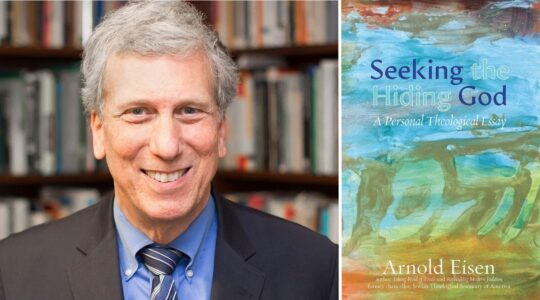There was a time when American Jewish families sat shiva when a child married out of the faith. Even two or three decades ago the prevailing attitude was one of disappointment, embarrassment and regret, coupled with a parental commitment to make the best of it and hope the grandchildren would be raised as Jews.
Times have changed. With the increase in intermarriage has come greater communal acceptance, to the degree that for some Jewish religious leaders it is no longer standard to publicly endorse endogamy, or Jewish in-marriage. For them intermarriage is viewed as an opportunity to be embraced. And those who express deep concern about the American Jewish future based on the dramatic increase in interfaith weddings are perceived as sociological and theological Neanderthals, fighting a losing battle — indeed the wrong one — against a trend that represents an opportunity to assure the Jewish future.
Consider this excerpt from the major address given by Rabbi Rick Jacobs, president of the Union for Reform Judaism, at last month’s biennial of the Reform movement in San Diego.
“Incredibly enough … I still hear Jewish leaders talk about intermarriage as if it were a disease,” he told some 5,000 constituents. “It is not. It is a result of the open society that no one here wants to close. The sociology is clear enough; anti-Semitism is down; Jews feel welcome; we mix easily with others; Jewish North Americans (researchers say) are more admired overall than any other religious group. So of course you get high intermarriage rates — the norm, incidentally, in the third or fourth generation of other ethnic groups as well.
“In North America today, being ‘against’ intermarriage is like being ‘against’ gravity; you can say it all you want, but it’s a fact of life. And what would you prefer? More anti-Semitism? That people did not feel as comfortable with us?
“In any event, we practice outreach because it is good for the Jewish people. Interfaith couples can raise phenomenally committed Jewish families, especially when they do it in the Jewish community that is offered uniquely by the Reform movement.”
It’s true, as Rabbi Jacobs suggests, that interfaith couples can raise deeply committed Jews. I admire him and his work, and I hope his movement is successful in its ambitious plans to make that happen. But the jury is definitely out, with demographic experts debating whether the glass is half full or half empty, based on the findings of the recent Pew Research Center study on Jewish identity. The optimists acknowledge that while it is far more likely that children of intermarriage say they have no religion, 59 percent of that cohort who are adults under 30 say they are Jewish, a significant increase in recent years. “In this sense, intermarriage may be transmitting Jewish identity to a growing number of Americans,” write Pew researchers Greg Smith and Alan Cooperman.
Others say that only a small percentage of adult children of intermarriage marry Jews, and that based on projections of current data, less than 10 percent of them will in turn raise their children as Jews. Sociologist Steven M. Cohen cites the remark of the late American Jewish Committee sociologist Milton Himmelfarb when asked what to call the grandchildren of intermarried Jews. “Christian,” he said. (Cohen adds: “He was approximately 92 percent correct.)
Commenting on Rabbi Jacobs’ biennial remarks, Cohen said he thought it “irresponsible” for the Reform leader not to promote Jews marrying Jews. “Isn’t it an inherent obligation” for him to do so? he asked. And just because it may be going against the popular grain, “does that mean rabbis shouldn’t encourage Shabbat observance, keeping kosher, etc.?”
Rabbi Elliot Cosgrove, spiritual leader of Park Avenue Synagogue and a leading voice in the Conservative movement, shares that concern. “There is a difference between the descriptive condition of American Jewry and the role of Jewish leadership. It’s not an either/or proposition,” he said, adding that his community “will continue to unapologetically preach the value of endogamy — marrying within the Jewish faith — and we will unrepentantly work to facilitate the journey of would-be Jews into our family. I am, we are, in the business of creating Jewish homes.”
So is the Reform community, Rabbi Jacobs says. He told me he agrees that “the issue is not endogamy vs. outreach, but how do we use the power, beauty and inspiration of Judaism to bring more [interfaith] families into the fold by practicing our leadership differently.”
Support the New York Jewish Week
Our nonprofit newsroom depends on readers like you. Make a donation now to support independent Jewish journalism in New York.
He described “the birth of outreach” as Rabbi Alexander Schindler’s decision, as head of the Reform movement in the late 1970s, to endorse patrilineal descent. Rabbi Jacobs said “the finger-wagging of inreach is yesterday,” and a turnoff for intermarried Jews who may be searching for ways “to make Jewish choices and live a Jewish life of purpose and depth.”
His job, our job, is to be there for them, he said. He cited the benefits of what he calls “audacious hospitality,” noting the number of dedicated people, including rabbis, he knows who have come to Judaism through its warmth. “That’s the strategy for the Jewish future,” Rabbi Jacobs said. “We have to engage the next generation with on-ramps” (to Jewish life) because “the majority of them will be the children of intermarriages, and potentially our leaders.”
Potentially. Or they may disappear from the Jewish ranks.
While I don’t think of intermarriage as “a disease,” to cite Rabbi Jacobs’ phrase, I do believe its becoming the norm poses a threat to the sustainability of American Jewish life.
I am not alone in this assessment. Last week about two dozen like-minded concerned Jews — including rabbis, sociologists, lay leaders and journalists (myself included) — came together for a five-hour meeting in Midtown. The purpose was to offer reflections on the data of the Pew study and, perhaps more importantly, discuss whether and how to call for a kind of communal intervention. In other words, to force leadership to recognize the trends that would seem to portend a sharp decrease in the number of Jewishly engaged non-Orthodox Jews in the U.S. over the next few decades due to increasing intermarriage, late marriage and low fertility rates.
In a paper called “Can We Have Continuity Without Jewish Content?” Steven Bayme, national director of the department of contemporary Jewish life at AJC, and Jack Wertheimer, a professor at the Jewish Theological Seminary, described to the group the current attitude of communal leaders as “a conspiracy of silence” in dealing with these issues. And they wrote that “a cascade of ever-lower expectations” is resulting in a “culture of consensus” appealing “only to the lowest common denominator” of Jewish identity and engagement.
One example of this “silence” is what appears to me to be a growing reluctance among rabbis and families to encourage the non-Jewish partner to convert before marriage. The thinking is not to pressure the fiancé (or more often, fiancée), and hope an interest in becoming Jewish will increase during the marriage. Or if that doesn’t happen, that the non-Jewish partner will, at least, agree to raise the children as Jewish.
I plan to report more fully next week on the group’s discussions, and the resulting proposals and implications. For now, I leave you with the approach of Barry Shrage, president of the Combined Jewish Philanthropies of Boston; his community is seen as a leader in successfully reaching out to interfaith families.
“The important question is not how many Jews there are or will be,” he wrote recently, “but rather what kind of Jewish life we want for our children and grandchildren and communities. What is ‘a Jewish life’ and how do we build it?”
What all sides – at least among the activists in this discussion – seem to agree on is the need for a strong communal response to the current drift, whether it’s in the form of “audacious hospitality” or raising the bar of obligation and responsibility. For now, though, the quiet but perfect storm continues — increasing intermarriage, fewer children, less affiliation, and costly or insufficient Jewish educational opportunities. If our religious and communal leaders have neither the strategy, willingness nor fortitude to stem or reverse the tide, the battle is lost. But first we have to recognize that we are in crisis and agree on what we are fighting for.
Email: Gary@jewishweek.org
Next week: Convincing the community we are losing the continuity battle, and what to do about it.
Support the New York Jewish Week
Our nonprofit newsroom depends on readers like you. Make a donation now to support independent Jewish journalism in New York.
The New York Jewish Week brings you the stories behind the headlines, keeping you connected to Jewish life in New York. Help sustain the reporting you trust by donating today.





